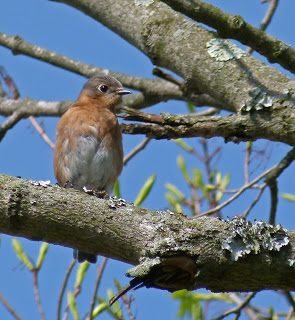
Bluebirds are wonderful parents. I think the same pair return to the same nest box year after year, although I admit, it is hard to tell them apart! In this photo, notice the male bringing a nice worm for the chicks, while the female removes a fecal sac. A fecal sac is a clean, tough mucous/gelatinous membrane/film containing the excrement of nestling birds. Yes, baby birds poop in diapers! Nestlings usually excrete one sac after each feeding, especially as they get older. The parent grasps the sac by the middle with their beak. They may take out 60-70 bundles a day! Usually both parents help with this task. For hatchlings and very young nestlings (e.g., up to 4-5 days old), the parents may eat the sacs, as the baby’s digestive tracts are not very efficient and the sacs may still contain nutrition. Otherwise, they drop them outside of the box, usually some distance away to avoid leading predators back to the nest.
If you are interested in learning more about Bluebirds, Sialis.org is the source of all knowledge relating to them. The safe way to observe eggs and chicks is to use a mirror, for example. The nests have a deep cup, and it’s hard to see the inside sometimes. The mirror ensures that you don’t accidentally break an egg while exploring with a fingertip.
Not all cavity nesters are as tolerant as Bluebirds, who will wait patiently on a nearby branch while you visit their youngsters. Just be careful not to take too long. After all, those babies are growing fast and always hungry! Only 3 weeks after hatching, they will be ready to “fledge,” or fly out of the nest. We see pictures of eagles and other birds flapping their wings in preparation for fledging. But cavity nesters don’t have room for this. Remember, there may be 5-6 chicks crammed inside that box, but when it’s time to fly, they jump out of the hole and never look back.
Both parents will feed the nestlings. What bluebirds eat depends in part on what is available. On average over the seasons, 68% of a Bluebirds’ diet is made up of insects: grasshoppers, crickets, beetles, spiders, and caterpillars (usually spied from a perch and then caught on the ground.) They also eat ants, wasps and bees, flies, angleworms, snails, sow bugs, moths, weevils and termites. Bluebirds love mealworms, and you can put them out in a dish to attract nearby Bluebirds. Occasionally they catch insects in flight, especially when its warmer and flying insects are abundant. The proportion of insects in the food bluebirds collect during nesting season is probably significantly higher than 68%. That is because their growing young need lots of protein. The rest is mostly small fruit – e.g., flowering dogwood, holly, mulberry, wild grape, Virginia creeper, pokeweed, and Viburnum, gleaned from plants or foraged on the ground. In winter, I have watched them eating mistletoe berries and poison ivy berries, since Kentucky Bluebirds usually spend the winter here instead of migrating.
As the saying goes, “May all your blues be birds.” Hope to see you at Bluebird Day, May 18, from 10 – 2.




